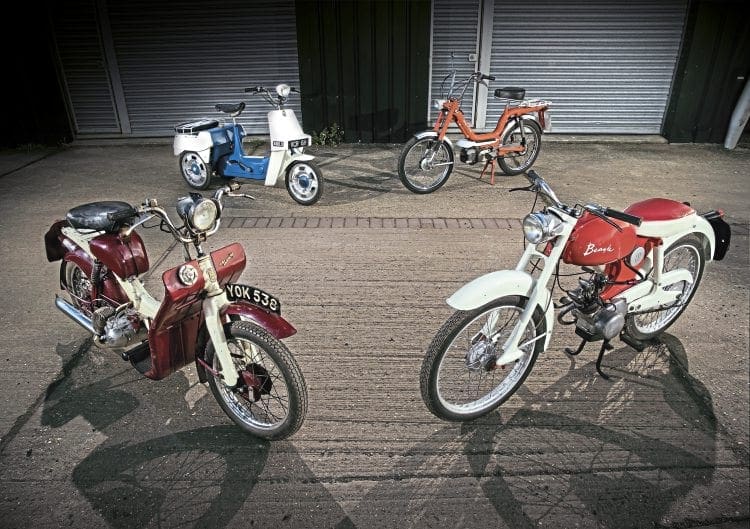This collection of British ultra-lightweight losers should have been depressing – but putting them through their paces proved a right hoot! First off, the BSA Dandy and Beagle…
Words: STEVE WILSONPhotographs: JONATHAN FLEETWOOD
Ken Powell is a welder from the Isle of Wight and the Other Island seems a suitably eccentric time-warp for his extensive collection of old and unusual motorcycles.
Enjoy more Classic MotorCycle reading in the monthly magazine.
Click here to subscribe & save.
It doesn’t hurt that Ken, as well as a skilled, inventive mechanic, is a witty guy who doesn’t take himself or the bikes too seriously.
From them we selected four flyweights that exemplified BSA’s repeated failure to succeed in this profitable sector.
Our four riders were your correspondent, Ken himself, Dave Richmond (once the rally columnist on Motor Cycling Weekly) and his pal Derk Bruinsma, an expert engineer.

What none of us expected was how much fun it would be!
1959 BSA Dandy
What was it?
The 70cc Dandy ‘scooterette’ was originally laid out by Bert Hopwood, before he left BSA in 1955. It was a unit construction, 45x44mm two-stroke single, riding on 15in wheels.
It included the scooter virtues of weather protection, some concealed mechanicals – the carburettor was out of sight behind a slotted cover in the crankcase – and a step-through frame.
It was female-friendly, and BSA’s publicity invariably featured lady riders in skirts.
Its many ingenious features for novices included (to spare footwear) a hand starting lever down on the left, but journalist Bob Currie had broken this on a prototype, and production models featured a left-side kickstarter.
For compactness, the rear swinging-fork was attached to the backward-facing, horizontal engine unit.
Brackets joined the crankcase to the right fork’s pivot position on the pressed steel frame, with the single cylinder forming part of that fork.

On the nearside, a further steel pressing mounted on the gearbox formed the left fork arm. The front forks were leading link, and the brakes four-inch front and rear.
The gearchange was equally innovative, featuring a two-speed pre-selector.
Turning the left twistgrip towards you for first, as shown on a metal indicator next to the grip, and nothing happened until you pulled in the clutch, and released it to move away.
For second you twisted the grip all the way forward and repeated the procedure, with neutral in the middle. Electrics were via a flywheel mag located in the middle of the crankcase, along with the points.
The “Handy” Dandy weighed in at 115lbs, claimed 130-plus mpg, and had a top speed on test of 33mph.
What went wrong?
As Hopwood later pointed out, his original design specified a heat-dissipating alloy cylinder with a chrome bore, but the production barrel became cast iron, and hot running meant that piston seizures were far from unknown.

However, the real problem was the buried points.
Ken speaks from experience: “To get at them, you have to remove the rear shocks, the electrical connections and the clutch.
“Then the bike won’t stand up, so you have to hang it from the rafters. On the clutch there’s a set of fingers that engage with the flywheel.
“You have to separate them and move the flywheel to get at the points. It’s a half-a-day job.”
Read more and view more images in the August 2019 issue of TCM – on sale now!
Advert
 Enjoy more The Classic MotorCycle reading in the monthly magazine. Click here to subscribe.
Enjoy more The Classic MotorCycle reading in the monthly magazine. Click here to subscribe.



